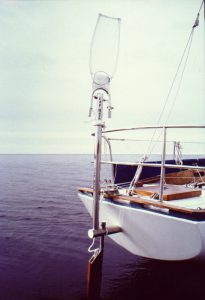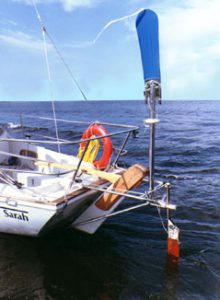How CapeHorn
makes boats steer themselves
|
Yves Gélinas explains how the CapeHorn models came to be My Alberg 30 Jean-du-Sud has a lovely classic transom, and to render the gear that would make it steer itself as discrete as possible, I thought of hiding some of it inside the lazarette. A horizontal tube is made to pass through the transom, its forward end supported by a pair of struts; inside it, another smaller tube links the servo-pendulum trailing outside to a quadrant inside, with lines to the boat’s steering gear. A vertical tube links the servo-pendulum to a vane in clear air above. I could not make it more discrete, or more solid, the gear being as strong as the stern of the boat. I called it the Jean-du-Sud model. |
 |
|
I increased the scantlings to steer boats 40′ and above; Spray model. The self-steering gear is integrated into the boat; part of it is inside, with lines led internally to the boat’s steering systen, then jamming cleats in the cockpit. It also integrates electric autopilot steering when you drive the servo-pendulum with a small tiller pilot. Power to move the rudder still comes from the servo-pendulum, the autopilot feeds on mere milli-amps and is never overworked. Each gear is custom-built: the length of the horizontal axle varies on each boat to locate our quadrant in the most favourable position inside, regardless of the shape of the stern, whether it is classic, reverse or canoe. Height of the windvane tower is measured to locate the vane in clear air above a bimini; wetted area of the servo-pendulum remains proportional to the boat’s rudder . |
 |
|
I was asked to make the last Contessa 26 built by JJ Taylor steer itself. |
 |
|
Then Joshua, same configuration, but with the scantlings of the Spray. Those two models are totally outboard and will steer the boat whenever an integrated installation is impossible. |
 |
|
When I was asked to make my first boat with a scoop stern steer itself, I figured I could use the Varuna configuration, but without the mounting arms, and with the horizontal axle directly on the scoop, long enough |
 |
|
Early on, I figured there was no reason a gear should be smack on the centre line. On Nicholson 31 Chance Encounter , we offset the horizontal axle to allow the outboard rudder to pivot. |
 |
|
Kim and Charlie Arcon honeymooned on Toucana, their Westsail 32, |
 |
|
Annapolis 44 Jade had a long overhang with very raked transom |
 |
|
Moody 42 Tristaina from Ibiza had a step stern with davits. So we located the windvane tower at the forward end of the horizontal axle, in front of the CapeHorn quadrant and made it pass through the stern deck. |
 |
|
With his wife and two teen-age daughters as crew, Rolland Trowbridge wanted to sail Precipice, a 32’ gaff-rigged cutter he had built himself, through the North-West passage. He needed a compact, sturdy integrated installation, but there was no space inside for the CapeHorn quadrant. Instead, we welded straps on the tube supporting the servo-pendulum for our control lines and led them to the back of the rudder head. |
 |
|
Bruce Robertson had the same demand for his Morris 26 Anihoya; he wanted a bullet-proof gear. But on a Norwegian stern, no place for turning blocks. We replaced our control lines with a rigid arm dropped into a pin on the back of the rudder head. There was the Anihoya model. That was in 2010. Since then, I did not have to invent a new model, |
 |

